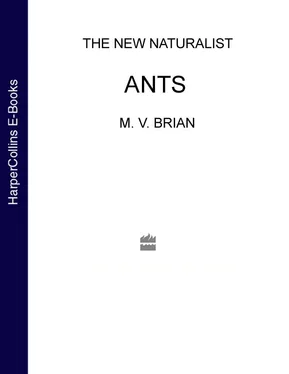This southerly tendency can be seen in ant distribution over the whole world. The humid Tropics have by far the greatest number. No doubt temperature is the most important single factor in this but rainfall, soil type, vegetation and humidity are subsidiary and of course highly interrelated. In this country the temperature of the soil where the ants live is probably more important than the air temperature and ant distribution is strongly influenced by the hours of sunshine in spring; this can be seen very clearly from fig. 8in which the hours of sunshine in May have been plotted over the number of species per vice-county.
FIG. 8. The number of species of ant per vice-county and the zones where daily sunlight in May averages 6 to 7 hours. Black: over 30 species; densely dotted: over 20; lightly dotted: over 10; blank: between 1 and 10. The information on ants was obtained from the Transactions of the Society for British Entomology , Volume 16, Part 3, pages 93–121, Collingwood, C. A. and Barrett, K. E. J. The information on sunlight is from the Climatological Atlas of the British Isles , published by H.M.S.O. in 1952.
EARLY ants lived on soil insects and this is still true of some primitive Ponerines. As simple predators ants were rather a long way from the primary source of food, the green plant, and their scope for population growth and spread and evolution was limited. The use of plant carbohydrates for energy, saving protein-rich foods, cannot have been long delayed as nectar-gathering is well established in the other primitive branch, the Myrmeciinae. Nectar is the common source of sugar in nature but other sources such as honeydew and fruit, both of which are quite easily recognized from their sugar and organic acid content, are more often used by ants. Seeds, though they are a very valuable source of food, are not eaten much, perhaps because their nutritive value is less easily recognized; they are, after all, covered in a tough skin. Fungi also have food value but are hardly used at all, though some of their threads which enter nest cavities from the surrounding wood or soil or which grow on their rubbish heaps may be cut and eaten. Only one group of ants, in tropical America, eat fungi regularly and systematically and these are cultivated in the nest and fed on vegetation which the ants collect regularly.
Most predatory ants have a varied diet which usually includes a lot of small invertebrate animals of about their own size and an occasional vertebrate corpse. They are not impressive as hunters but not a great deal is in fact known about the circumstances in which they catch their prey and there is much work to be done in this field. From what is known so far it appears that they can detect other animals from a distance of a few centimetres. Thus wood ants are known to be able to see movements 10 cm away. In soil spaces and perhaps in foliage ants may be able to detect the vibrations made by small animals moving through the substratum and they certainly have an acute sense of smell. Once they have received a distance signal they approach slowly, alert for others, probably mainly smells, before actually attacking. As they get nearer to the potential prey they orientate with their head forward, jaws open and antennae retracted and make further exploratory movements. Clearly, they must not throw themselves into the jaws of an enemy and a secure grip on prey is an obvious advantage. Finally they pounce and snap. If a hold is obtained, usually on a leg or antenna, they quickly bring round their gaster and inject poison with their sting if they have one, otherwise they spray penetrating or adhesive toxins. Not many ants are really alone when hunting, there are others nearby usually that help by flushing out prey or gathering round to help pin one down; they are more dog-like than cat-like on the whole.
Many small invertebrates are easily caught and immobilized; the small larvae of flies and moths and beetles, for example. Many others, particularly adults, have escape mechanisms. Thus, springtails (Collembola), which are very much valued as food by Myrmica and Lasius , can usually escape instantly by jumping but are easily caught while they are changing their skins, stuck in a water droplet or in some way damaged. The larvae of many sawflies and moths can flick their bodies smartly, others are so hairy that ants find them difficult to get hold of and many caterpillars can simply slip away on a thread of silk; some protect themselves with a case of vegetable material. To escape, other insects kick or produce repellents or sticky exudates from special skin glands, such as the cornicles of aphids. Those with a hard, shiny cuticle, like beetles, may be difficult to grip and impossible to sting. The great variety of these defensive mechanisms make it highly probable that many prey animals are only caught when they are incapacitated, perhaps through age, perhaps by mechanical damage (such as being trodden on), by wing failure, by the necessity to moult or even by transient low temperatures or weak light (some insects can only fly in sunlight). Bugs, flies and spiders comprised 80–90% of the number of prey caught by species of Myrmica. Small spiders that live on and near the soil surface are a major constituent of this food (11–38% in different years). In Polish grassland from 1700 to 4000 spiders were caught in a year in one square metre. In May, June and July, when feeding peaks, between sixteen and seventy-four spiders may be taken each day from one square metre.
Undoubtedly, an important element in the diet of most ants is other ants. Each summer they eat large numbers of sexuals, both of their own and other species, especially those that are unlucky enough to descend after the mating flight on to already occupied territory. Also, in spring when food is scarce and catastrophic fires destroy the vegetation, a wider search for food often leads to fighting between workers of different colonies and species in which a lot die. The corpses are taken back to the nest and sucked dry: an economical way of adjusting the population to a sharp drop in food supply.
Information is very much needed about the food of different colonies and species at different times of year. Some ecologists have taken samples of foragers on their return to the nest and identified what they were carrying. One has recently invented an ingenious trap which has been used to study the food of the wood ant, a species with two advantages: well-defined tracks above ground and large workers. A whole nest was surrounded by a barrier soaked in repellent oil and workers were induced to pass over this on specially constructed wooden bridges. One was used for incoming and the other for outgoing traffic. This was possible because although ants are prepared to drop a few centimetres from the end of a bridge on to the soil below they cannot reach up to return the same way. So, it was only necessary to place strips with the drop outside the barrier to take outgoing traffic and the drop inside the barrier for ingoing traffic. Those returning dropped into a box from which they could only escape by small holes little bigger than their bodies and they left behind anything they had been carrying in their jaws. Perhaps some day, traps on a similar principle will be devised for ants which forage underground, but this is likely to be much more difficult.
Wood ants eat many invertebrates which they catch both in the trees and on the ground. A large number of these are flies (including midges and crane flies ( Tipula spp.)) and many kinds of aphids; also, in season, winged ants, particularly of the genera Lasius and Myrmica . A lot of these insects are forest pests and the establishment of wood ant populations has become, at least in Europe, an important part of woodland management. In years when defoliating insects are very abundant and trees are stripped of their leaves in summer, conspicuous green islands are left around areas where ants nest. These defoliators include the larvae of various moths and sawflies that feed on oaks, pine, spruce and larch. Pupae and adults are also eaten. There are indications that wood ants will attack moving things in preference to quiet, still ones; yet it was found by trapping that they collected a lot of prey at night. There are of course a great many flying insects that settle in the foliage of trees and bushes during darkness; these could perhaps be easily located by smell. A wood ants’ nest was surrounded by guttering into which they threw their refuse. This not only consisted of empty cocoon fragments as expected but of many other insects and other odd items that were collected but not eaten; evidently they take in a great many more things than they use.
Читать дальше












